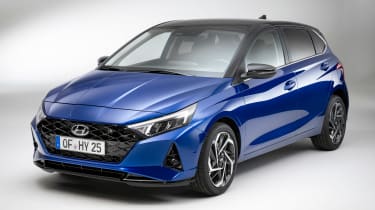New 2020 Hyundai i20 arrives with hybrid power
Cabin of Hyundai’s i20 revealed; comprehensive kit list plus mild hybrid tech on offer when sales begin in September
Following on from the official debut of the new Hyundai i20’s exterior, the Korean brand has now officially opened the car’s doors and granted access to the supermini’s interior. In terms of design, build quality and tech, the new cabin takes a giant leap forward relative to the outgoing car.
The next i20 is due to hit showrooms in September, when it will try to steal a march on talented rivals such as the Ford Fiesta and Renault Clio by delivering superior safety kit, class-leading in-car entertainment and mild-hybrid powertrains.
While the i20 uses a heavily updated version of the current model’s platform, from a design point of view it takes a radical departure from its predecessor. It’s the first Hyundai to use the company’s new design language, which means more sharply defined body surfacing and angular headlights (featuring full LEDs on top models), which blend into the edges of the wide grille.
At the back, the new model gets a full-width strip connecting the tail-lights, and they sit below a panel which, when combined with a black contrasting roof, blends into the rear window. Beyond the black roof, there are also four new exterior paint colours to choose from. The sportier stance is helped by the overall shape; the new i20 is 24mm lower, 30mm wider and 5mm longer than its predecessor.
The new cabin features soft touch, textured plastics across much of the dashboard, while the four-spoke steering wheel design is all-new. Ambient lighting, available on higher trim levels, lends the i20 a posher feel than its predecessor. The centre of the dash is broken up by horizontal slats that run the width of the cabin and blend into the car’s air vents, while above it sit the infotainment controls.
Top-spec versions feature a pair of 10.25-inch digital displays on the dash, which sit alongside each other in a Mercedes-like fashion. One screen, sitting directly ahead of the driver, acts as a digital instrument panel with graphics that change according to driving mode. The second unit features touchscreen functionality, allowing users to control the car’s infotainment functions. An eight-inch touchscreen is fitted to entry-level versions, and this still features Apple CarPlay and Android Auto. Wireless charging is also offered. Despite the large screens, heating and ventilation controls are still kept separate on physical controls lower down on the dash.
Elsewhere, the i20’s overall wheelbase has grown by a modest 10mm, but a small increase in interior space beyond the last i20 – already one of the most spacious superminis – gives Hyundai ground to claim that this is one of the most practical cars in its class. Boot space is up by 25 litres too, to 351 litres – not quite as large as the new Clio’s, but 48 litres more than in a Fiesta.
The i20’s petrol-only engine line-up is related to the previous car’s, but each unit gains efficiency tweaks to reduce fuel consumption. While other markets are set to get a 1.2-litre with 83bhp and a 1.0-litre turbocharged 48-volt mild hybrid with 118bhp, the UK is likely to get just one engine: a 99bhp 1.0-litre three-cylinder turbo mild hybrid. This set-up recovers energy that would otherwise be wasted under deceleration, and can redeploy that power to reduce load on the engine.
Gearbox choices are either a seven-speed dual-clutch automatic or a new six-speed manual. The latter features an electronic clutch, which is able to decouple the gearbox from the engine when coasting to save fuel.
Efficiency is also improved courtesy of the fact that the new i20 is roughly four per cent lighter than the outgoing model – a result of lighter seats, plus a plastic fuel tank in place of the old car’s steel item. The i20 features a flap in the front grille as well, which improves aerodynamic efficiency (itself saving roughly 2g/km of CO2). All of these changes mean the new car is estimated to be up to four per cent more fuel efficient than the old i20.
Performance figures have yet to be revealed, but the lighter body is likely to have a positive effect here, too. Prices have yet to be confirmed, but are likely to rise slightly, starting at around £15,500.
Do you think the Hyundai i20 can jump above the Renault Clio and Ford Fiesta to lead the supermini class? Let us know below...
Find a car with the experts





